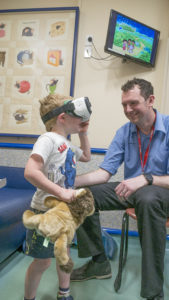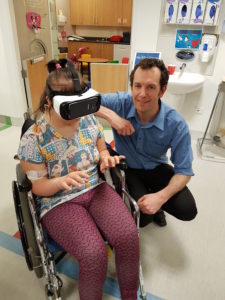A Virtual Wonder for Young Patients

Enterprising Peter Dooley is continuing to help children with cancer and older patients prepare for medical imaging tests and other procedures via the wonders of Virtual Reality (VR).
Mr Dooley, the Magnetic Resonance Imaging (MRI) Team Leader at the Canterbury District Health Board, has created a VR program giving New Zealand children a ‘virtual’ tour of the MRI room.
The program helps calm the nerves of the young patients before treatment and scans, reducing the need for patients – particularly young children – needing a general anaesthetic and also helping them understand more about the forthcoming scan.
Mr Dooley, who will be presenting on his VR work at the forthcoming Australian Society of Medical Imaging and Radiation Therapy Conference in Canberra, said the program aimed to “empower” patients.
“I suppose if you tell people something it can go in one ear and out the other, but by showing them some pictures it will stick in their minds,” he said. “I have a passion for MRI and don’t think people should be scared of having these scans.
“Caring and respecting patients is also our number one goal.
“It’s nice that children trust someone in what can seem a ‘scary’ environment. When they leave and they happily grab my hand, it’s a good feeling.”
Mr Dooley designed and implemented the VR program, which is mainly aimed at children aged three to six, about three years ago.
The five-minute program gives children a ‘virtual tour’ of the MRI room, allows them to see scans and processes they may undergo and some of the imaging equipment involved.
Mr Dooley, who has several years’ clinical experience working in New Zealand and was elected the South Island representative of the Society of MR Radiographers and Technologists in 2015, said the scheme had clearly benefitted patients and hospital staff.
“These children would have had general anaesthetics to get through the scans in the past,” he said. “They may have been scared heading into MRIs in the past, but now they want to come back for more.
“Our anaesthetists are happy as it has helped reduce their workload and waiting lists, while it has also helped reduce the demands on our paediatricians as well.”
Mr Dooley’s program has been featured extensively in New Zealand media and he believes it is revolutionary.
“I know there are different versions out there (being used at hospitals), but I don’t think there’s anything quite like this,” he said. “We’ve been contacting departments across the world and no-one has as yet said they are also using this.
“As a father of two young children, I guess I am passionate about making childrens’ experience of hospital a bit better.”
Mr Dooley is now hoping to progress his work further and has secured further funding, which he hopes will help his program become more “mainstream”. He has been working on other projects, including a VR program aimed at helping other young patients who are hospitalized.

The program can help prepare young children for various scans and treatment, including radiation therapy.
Another useful application might be for patients needing to undergo radiation therapy for cancer. Many children in this setting also need to be anaesthetised to keep them very still for treatment, so improved preparation for this potentially scary experience for patients of all ages would be highly beneficial.
“The aim is to one day have (this program) on a platform available for anyone to use,” Mr Dooley said.
Mr Dooley has been busy devising other applications of VR and recently helped a young girl who has spent 130 days in hospital. Her boyfriend took a 360 camera up to a favourite lake she liked to visit, recording some of her favourite images. This could then be viewed on the VR system and she could look at the blue sky, hear the birds singing and be reminded of this special place.
“Not only does she feels something special, but her loved ones also feel they have done something for her.”
Mr Dooley will be presenting on his work at with the theme ‘Using Virtual Reality in a Clinical Setting’ at the ASMIRT Conference, which takes place in Canberra from March 15-18.
Click here to see footage of the VR project in action (courtesy tvnz).
For more about the role of imaging and radiation therapy, click here.




